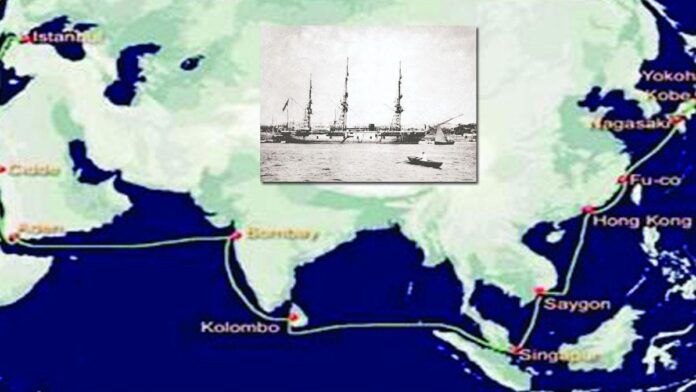The tragic end of the Ertuğrul Frigate brought Turks and Japanese closer together, if not allies. However, despite the fact that more than 130 years have passed, we cannot say that the Turks know the Japanese well, and we also see that the economic relations are far from the level they should be.
Turkish-Japanese Relations were not at a high level until the Far East Program of the Ertuğrul Frigate. The Japanese and the Turks began to get to know each other through the information they obtained directly, in the second half of the 19th century, at a time that could be considered late. However, it was Mahmud of Kashgar who drew the first Japanese map in the 11th century and showed his position in the world. He drew Japan as an island in the easternmost part of the world map in his work Divân-ü Lugâti’t-Türk and noted that others could not learn the languages of this country because the seas could not be crossed.
The first Japanese map drawn by the Japanese to date is the 1303 map found in a temple near Kyoto. Westerners’ knowledge of Japan comes from Marco Polo (1254-1323). In the map dated 1492, which Martin Behaim drew before the discovery of America, Japan was randomly included with the information given by Marco Polo. The first accurate Japanese map was drawn in 1750 by Sieur Robert.
For the Ottomans, the first compact information about Japan was in Katip Çelebi’s (d.1657) book named Cihannümâ. The knowledge of the Japanese about the Ottoman Turks was based on the prejudiced reports received from Dutch sailors by the Tokugawa Shoguns, who were the head of the feudal administration before the 1868 Meiji restoration.
Great Power Politics
In the words of my esteemed Scholar Selçuk Esenbel, “The history of the Japanese interest in the Ottoman Empire in the 19th century reflects the motives, ideas and strategies that Japan used in its entry into the world of great power politics”.
In the contemporary period, the first steps towards establishing direct relations between the two countries came from the Japanese. The form of global trade and political relations established by the Western powers was disturbing both countries. Acting with the slogan of liberalization of world trade, the Western powers did not take into account the interests of other countries while removing the obstacles in front of them. This oppressive approach started the process of getting to know each other and establishing relations in order to evaluate the political and economic conditions of the two countries.
The 19th century has been a long century for the world as well. Free trade agreements such as the 1838 Treaty of Baltalimanı, which Britain made with the Ottoman Empire, also affected the USA. In the context of its policies to colonize the Far East, the United States, under Matthew Perry, sent navies in 1853 and 1854 to put pressure on Japan. Indeed, with the Kanagawa treaty, the Japanese made their ports free to US ships. Then Britain, the Netherlands, Russia and France achieved this goal in 1858 by forcing Japan to sign free trade agreements.
World order was being re-established when Japan abandoned passive policies to counter the cultural, political and economic pressures of Western powers.
Russo-Japanese Conflict
Leaving the 1853-1856 Crimean War with defeat, Russia, on the other hand, saw that it had to avoid conflict with the British and the French for a while, and turned its direction to the Far East. Russia’s implementation of the Trans-Siberian railway project has prompted Japan, which has a policy of expansion in Manchuria. Japan’s invasion of Korea made war with Russia inevitable. As a matter of fact, Japan won the war, which started in 1904 and ended in 1905.
While Russia was in question to suffer a more severe defeat, the USA intervened and forced Japan to make peace. Japan’s victory was met with great interest in the east and west of the world. Japan’s defeat of Russia as an Eastern power, whose borders extend from Asia to Europe and which wants to be considered as a Western country, was celebrated with joy in the Ottoman and Islamic geography. As a result of this victory, which Japan won with the effect of its innovation program since 1868, it became a source of inspiration for the countries exploited by the Western powers. As an eastern but modernized country, Japan has taken a significant distance in a short time in its policy of becoming an imperial power like England, France and the USA.
Meiji Restoration
Mutsuhito, who ascended to the Japanese throne at the age of 15 on February 3, 1867, used the adjective Meiji, meaning “enlightened government.” Emperor Meiji enacted an ambitious restoration policy in Japan during his reign, which lasted until 1912. While the Meiji Westernized his country, he also began to respond to the colonial policies of the Western powers. In 1868, he ended the 265-year feudal regime of the Tokugawa Shogunate. In 1871, he abolished the feudal order completely by carrying out land reform. A year later he established a new education system. In 1889, the Japanese constitution was proclaimed, and then the parliament of the constitutional monarchical order was established. The innovations made provided positive results in every field and showed their effect in the military field as well. The military might of the Japanese was proven by victories over China in 1894-5 and against Russia in 1904-1905.
Within the framework of the Meiji Westernization program, he sent a delegation to the USA and Europe in order to get to know the West in all its aspects, to examine its military and civilian institutions, to learn the real logic of its laws, and to grasp the essential spirit of technological progress. In this context, Fukuichi Genichiro came to the Ottoman Empire in 1871. After his report, the interest of Japanese diplomats in Istanbul increased. In 1876, a Japanese delegation visited the Ministry of Foreign Affairs and met with the minister.
Enlargement Policy
The Japanese naval training ship “Seika” arrived in Istanbul in 1878. The ship’s commander and officers moored in the Golden Horn attracted great attention. The ship’s commander and three officers stayed in Istanbul for 12 days. They were rewarded with an Ottoman medal by Abdülhamid.
Although Japanese diplomat Yoshida Masaharu, who came to Istanbul in 1880, attracted attention in the Ottoman capital, he did not succeed in signing any agreement between the two countries. Ottoman Sultan II. Abdulhamid did not want to draw the reaction of the two countries in question by signing an agreement with the Japanese, who were in competition with Russia and England. Aware of this, the Japanese wanted to make an agreement with the Ottoman Empire by sending a higher-level delegation. Since the Japanese interests conflicted with Russia in their enlargement policies, they were looking for ways to reach the Turkish world and Central Asia.
Because if they kept the Russians busy in Central Asia, the Japanese could eliminate an important rival in Manchuria and Asia’s Pacific coast. Therefore, they were looking for ways to communicate with the Turks and Muslim communities in Asia to establish cooperation with them.
While the French occupied Tunisia in 1881, the Japanese Emperor sent Prince Kato Hito to Istanbul with an official delegation. II. The delegation accepted by Abdulhamid is the first official Japanese delegation accepted by the sultan.
Ertugrul Disaster
The Ottoman Empire was having difficulties in terms of the balance policy followed by the Japanese since 1871. The Emperor’s brother Prince Komatsu and his wife, who made a trip to Europe in 1886, also visited Istanbul in 1887. II. Abdulhamid decided to prepare a delegation and send it to Japan in response to the Japanese delegations that have been coming and going for many years. The delegation’s departure with an Ottoman ship was seen as an opportunity to reflect the influence of the state in distant lands to the world public opinion. Ertuğrul Frigate departed from Istanbul with a ceremony on July 14, 1889, with a crew of around 600, headed by Osman Pasha’s delegation and captained by Miralay Ali Bey. Ertuğrul, who overcame a series of accidents in and after the Suez Canal, June 7, 1890 and arrived in Yokohama Harbor. The delegation, which presented the engagement and gifts sent by Abdulhamid the IInd to the Japanese Emperor with a great ceremony, decided to return after staying in Tokyo for about two months. Thirteen of the ship’s personnel were martyred because they could not be cured of the cholera they were caught. However, a great disaster struck during the return, which began on September 15, 1890. Ertuğrul, who was caught in a typhoon near the Oshima rocks on September 16, could not escape from the terrible sinking. Ertuğrul, who was caught in a typhoon near the Oshima rocks on September 16, could not escape from the terrible sinking.
While more than 500 sailors were killed in the crew, 69 sailors managed to escape. The leader of the ship and the convoy, Osman Pasha, and its captain, Ali Bey, were martyred in this disastrous incident. The survivors were first taken to the provincial port city of Kobe. Three months later, the survivors of the delegation, whose treatment, shelter and food were met in Japan, returned to Istanbul with the Japanese warship Hiei and Kongo. Arriving on January 2, 1891, the Japanese ship commander presented the check of the amount for the condolence aid obtained in the campaign initiated by the newspapers in Japan to the Porte authorities.
First trip and bitter end
The first sea voyage to Japan in Ottoman history resulted in a major accident. There were some who called this accident a disaster. However, such an important event has not been the subject of sufficient research until recent years. In the middle of the defeats in the Ottoman Russian War of 1877-78 and the Balkan Wars of 1912-13, it is understood why the pain of the losses in this accident is quickly forgotten when compared to the others.
The Ertuğrul Frigate made a visit that the Emperor of Japan had been waiting for many years, but could not complete its return. Other purposes of Ertuğrul’s travel to the Far East are the ideological reflection of Abdulhamid’s Islamic Union policy. Abdulhamid had begun to reinterpret the title of caliphate, which the Ottoman sultans cared more about since the loss of Crimea, in the context of the balance policy in foreign policy. In this context, the Ertuğrul Frigate stopped by the ports where the British and French Colonial administrations were active, giving the message that our faith in the Muslim communities there should be one, as well as our policy against the invaders. When they anchored in Suez, Jeddah, Aden, Mumbai, Ceylon, Singapore, Saigon, Hong Kong and their ports, Osman Pasha and the Muslim leaders of the region were eager to meet. There were news about Ertuğrul in the local newspapers, and the meetings with Pasha, the visit of Turkish sailors to places such as mosques, were given with great emotion.
The Ottomans called Ertuğrul a school and training ship in order not to provoke Russia. At the same time, he wanted to show that he had other strong friends in the world against European powers, especially England. In this context, they gave messages of alliance with Japan and received significant positive reactions from the Muslim communities in the colonial administrations. He wanted to show that he had other strong friends in the world against European powers, especially England. In this context, they gave messages of alliance with Japan and received significant positive reactions from the Muslim communities in the colonial administrations. He wanted to show that he had other strong friends in the world against European powers, especially England. In this context, they gave messages of alliance with Japan and received significant positive reactions from the Muslim communities in the colonial administrations.
Strengthening Alliance
The British, on the other hand, interpreted the visit in terms of not eroding their own interests. The British sought to strengthen their alliance with Japan in order to be comfortable in Egypt, which they occupied in 1882, and to protect their presence in Afghanistan and India against Russia.
Ertuğrul’s tragic end brought Turks and Japanese closer together, if not allies. However, despite the fact that more than 130 years have passed, we cannot say that the Turks know the Japanese well, and we also see that the economic relations are far from the level they should be. The heroic sailors of Ertuğrul went on a journey at the cost of their lives and laid the foundation of the relations between the two countries. Bless their souls. May the cultural and economic relations that will bring joy to their souls continue forever…
@suleymankzltprk





















